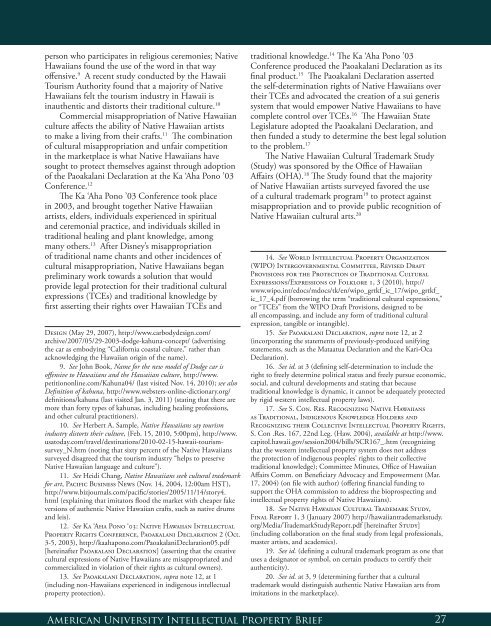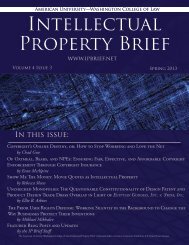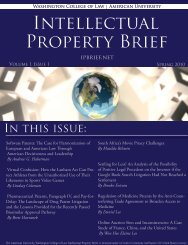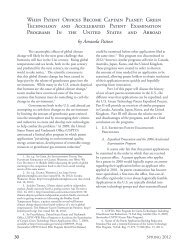The New Hawaiian Model: The Native Hawaiian Cultural Trademark ...
The New Hawaiian Model: The Native Hawaiian Cultural Trademark ...
The New Hawaiian Model: The Native Hawaiian Cultural Trademark ...
Create successful ePaper yourself
Turn your PDF publications into a flip-book with our unique Google optimized e-Paper software.
person who participates in religious ceremonies; <strong>Native</strong><br />
<strong>Hawaiian</strong>s found the use of the word in that way<br />
offensive. 9 A recent study conducted by the Hawaii<br />
Tourism Authority found that a majority of <strong>Native</strong><br />
<strong>Hawaiian</strong>s felt the tourism industry in Hawaii is<br />
inauthentic and distorts their traditional culture. 10<br />
Commercial misappropriation of <strong>Native</strong> <strong>Hawaiian</strong><br />
culture affects the ability of <strong>Native</strong> <strong>Hawaiian</strong> artists<br />
to make a living from their crafts. 11 <strong>The</strong> combination<br />
of cultural misappropriation and unfair competition<br />
in the marketplace is what <strong>Native</strong> <strong>Hawaiian</strong>s have<br />
sought to protect themselves against through adoption<br />
of the Paoakalani Declaration at the Ka ‘Aha Pono ’03<br />
Conference. 12<br />
<strong>The</strong> Ka ‘Aha Pono ’03 Conference took place<br />
in 2003, and brought together <strong>Native</strong> <strong>Hawaiian</strong><br />
artists, elders, individuals experienced in spiritual<br />
and ceremonial practice, and individuals skilled in<br />
traditional healing and plant knowledge, among<br />
many others. 13 After Disney’s misappropriation<br />
of traditional name chants and other incidences of<br />
cultural misappropriation, <strong>Native</strong> <strong>Hawaiian</strong>s began<br />
preliminary work towards a solution that would<br />
provide legal protection for their traditional cultural<br />
expressions (TCEs) and traditional knowledge by<br />
first asserting their rights over <strong>Hawaiian</strong> TCEs and<br />
Design (May 29, 2007), http://www.carbodydesign.com/<br />
archive/2007/05/29-2003-dodge-kahuna-concept/ (advertising<br />
the car as embodying “California coastal culture,” rather than<br />
acknowledging the <strong>Hawaiian</strong> origin of the name).<br />
9. See John Book, Name for the new model of Dodge car is<br />
offensive to <strong>Hawaiian</strong>s and the <strong>Hawaiian</strong> culture, http://www.<br />
petitiononline.com/Kahuna04/ (last visited Nov. 14, 2010); see also<br />
Definition of kahuna, http://www.websters-online-dictionary.org/<br />
definitions/kahuna (last visited Jan. 3, 2011) (stating that there are<br />
more than forty types of kahunas, including healing professions,<br />
and other cultural practitioners).<br />
10. See Herbert A. Sample, <strong>Native</strong> <strong>Hawaiian</strong>s say tourism<br />
industry distorts their culture, (Feb. 15, 2010, 5:00pm), http://www.<br />
usatoday.com/travel/destinations/2010-02-15-hawaii-tourismsurvey_N.htm<br />
(noting that sixty percent of the <strong>Native</strong> <strong>Hawaiian</strong>s<br />
surveyed disagreed that the tourism industry “helps to preserve<br />
<strong>Native</strong> <strong>Hawaiian</strong> language and culture”).<br />
11. See Heidi Chang, <strong>Native</strong> <strong>Hawaiian</strong>s seek cultural trademark<br />
for art, Pacific Business <strong>New</strong>s (Nov. 14, 2004, 12:00am HST),<br />
http://www.bizjournals.com/pacific/stories/2005/11/14/story4.<br />
html (explaining that imitators flood the market with cheaper fake<br />
versions of authentic <strong>Native</strong> <strong>Hawaiian</strong> crafts, such as native drums<br />
and leis).<br />
12. See Ka ‘Aha Pono ‘03: <strong>Native</strong> <strong>Hawaiian</strong> Intellectual<br />
Property Rights Conference, Paoakalani Declaration 2 (Oct.<br />
3-5, 2003), http://kaahapono.com/PaoakalaniDeclaration05.pdf<br />
[hereinafter Paoakalani Declaration] (asserting that the creative<br />
cultural expressions of <strong>Native</strong> <strong>Hawaiian</strong>s are misappropriated and<br />
commercialized in violation of their rights as cultural owners).<br />
13. See Paoakalani Declaration, supra note 12, at 1<br />
(including non-<strong>Hawaiian</strong>s experienced in indigenous intellectual<br />
property protection).<br />
traditional knowledge. 14 <strong>The</strong> Ka ‘Aha Pono ’03<br />
Conference produced the Paoakalani Declaration as its<br />
final product. 15 <strong>The</strong> Paoakalani Declaration asserted<br />
the self-determination rights of <strong>Native</strong> <strong>Hawaiian</strong>s over<br />
their TCEs and advocated the creation of a sui generis<br />
system that would empower <strong>Native</strong> <strong>Hawaiian</strong>s to have<br />
complete control over TCEs. 16 <strong>The</strong> <strong>Hawaiian</strong> State<br />
Legislature adopted the Paoakalani Declaration, and<br />
then funded a study to determine the best legal solution<br />
to the problem. 17<br />
<strong>The</strong> <strong>Native</strong> <strong>Hawaiian</strong> <strong>Cultural</strong> <strong>Trademark</strong> Study<br />
(Study) was sponsored by the Office of <strong>Hawaiian</strong><br />
Affairs (OHA). 18 <strong>The</strong> Study found that the majority<br />
of <strong>Native</strong> <strong>Hawaiian</strong> artists surveyed favored the use<br />
of a cultural trademark program 19 to protect against<br />
misappropriation and to provide public recognition of<br />
<strong>Native</strong> <strong>Hawaiian</strong> cultural arts. 20<br />
14. See World Intellectual Property Organization<br />
(WIPO) Intergovernmental Committee, Revised Draft<br />
Provisions for the Protection of Traditional <strong>Cultural</strong><br />
Expressions/Expressions of Folklore 1, 3 (2010), http://<br />
www.wipo.int/edocs/mdocs/tk/en/wipo_grtkf_ic_17/wipo_grtkf_<br />
ic_17_4.pdf (borrowing the term “traditional cultural expressions,”<br />
or “TCEs” from the WIPO Draft Provisions, designed to be<br />
all encompassing, and include any form of traditional cultural<br />
expression, tangible or intangible).<br />
15. See Paoakalani Declaration, supra note 12, at 2<br />
(incorporating the statements of previously-produced unifying<br />
statements, such as the Mataatua Declaration and the Kari-Oca<br />
Declaration).<br />
16. See id. at 3 (defining self-determination to include the<br />
right to freely determine political status and freely pursue economic,<br />
social, and cultural developments and stating that because<br />
traditional knowledge is dynamic, it cannot be adequately protected<br />
by rigid western intellectual property laws).<br />
17. See S. Con. Res. Recognizing <strong>Native</strong> <strong>Hawaiian</strong>s<br />
as Traditional, Indigenous Knowledge Holders and<br />
Recognizing their Collective Intellectual Property Rights,<br />
S. Con .Res. 167, 22nd Leg. (Haw. 2004), available at http://www.<br />
capitol.hawaii.gov/session2004/bills/SCR167_.htm (recognizing<br />
that the western intellectual property system does not address<br />
the protection of indigenous peoples’ rights to their collective<br />
traditional knowledge); Committee Minutes, Office of <strong>Hawaiian</strong><br />
Affairs Comm. on Beneficiary Advocacy and Empowerment (Mar.<br />
17, 2004) (on file with author) (offering financial funding to<br />
support the OHA commission to address the bioprospecting and<br />
intellectual property rights of <strong>Native</strong> <strong>Hawaiian</strong>s).<br />
18. See <strong>Native</strong> <strong>Hawaiian</strong> <strong>Cultural</strong> <strong>Trademark</strong> Study,<br />
Final Report 1, 3 (January 2007) http://hawaiiantrademarkstudy.<br />
org/Media/<strong>Trademark</strong>StudyReport.pdf [hereinafter Study]<br />
(including collaboration on the final study from legal professionals,<br />
master artists, and academics).<br />
19. See id. (defining a cultural trademark program as one that<br />
uses a designator or symbol, on certain products to certify their<br />
authenticity).<br />
20. See id. at 3, 9 (determining further that a cultural<br />
trademark would distinguish authentic <strong>Native</strong> <strong>Hawaiian</strong> arts from<br />
imitations in the marketplace).<br />
American University Intellectual Property Brief<br />
27








